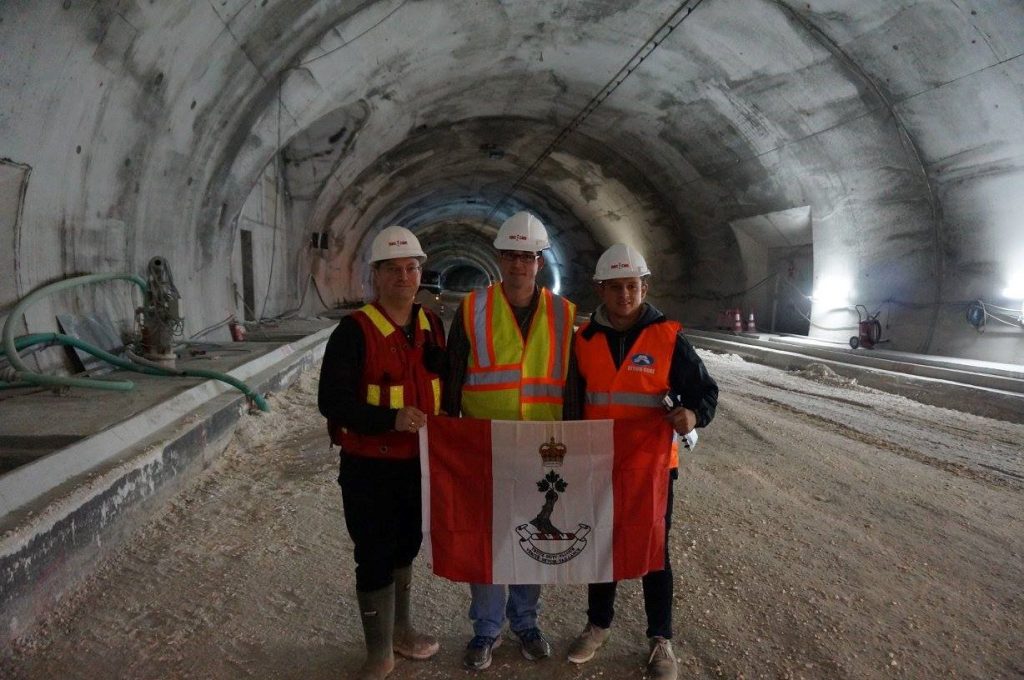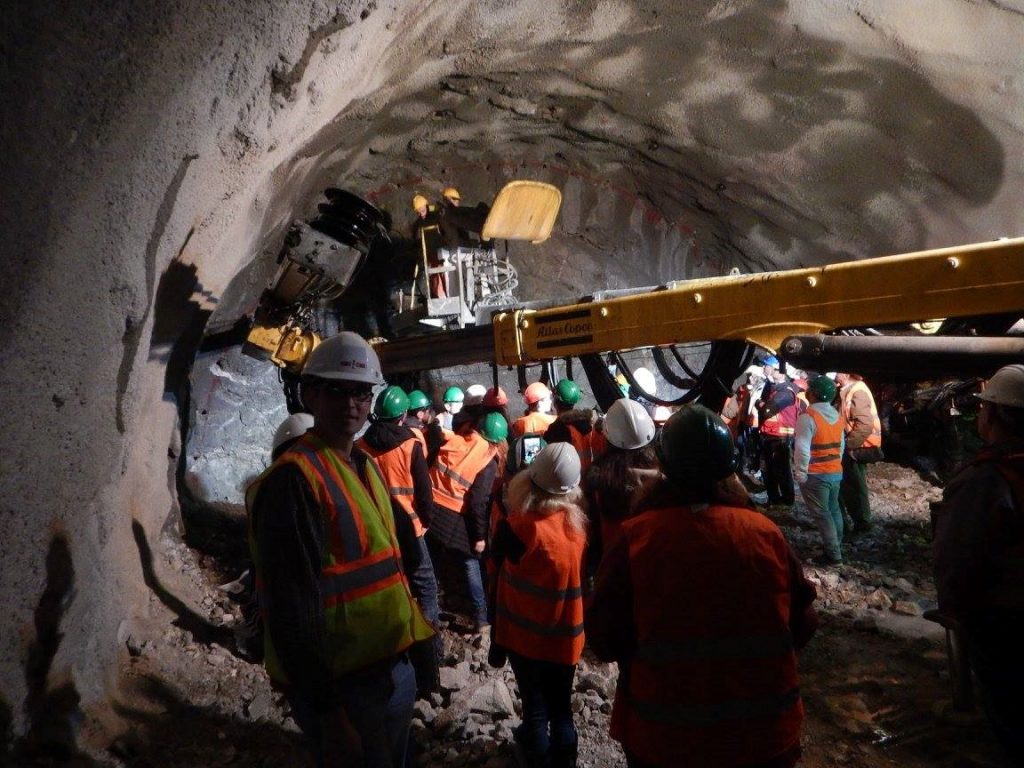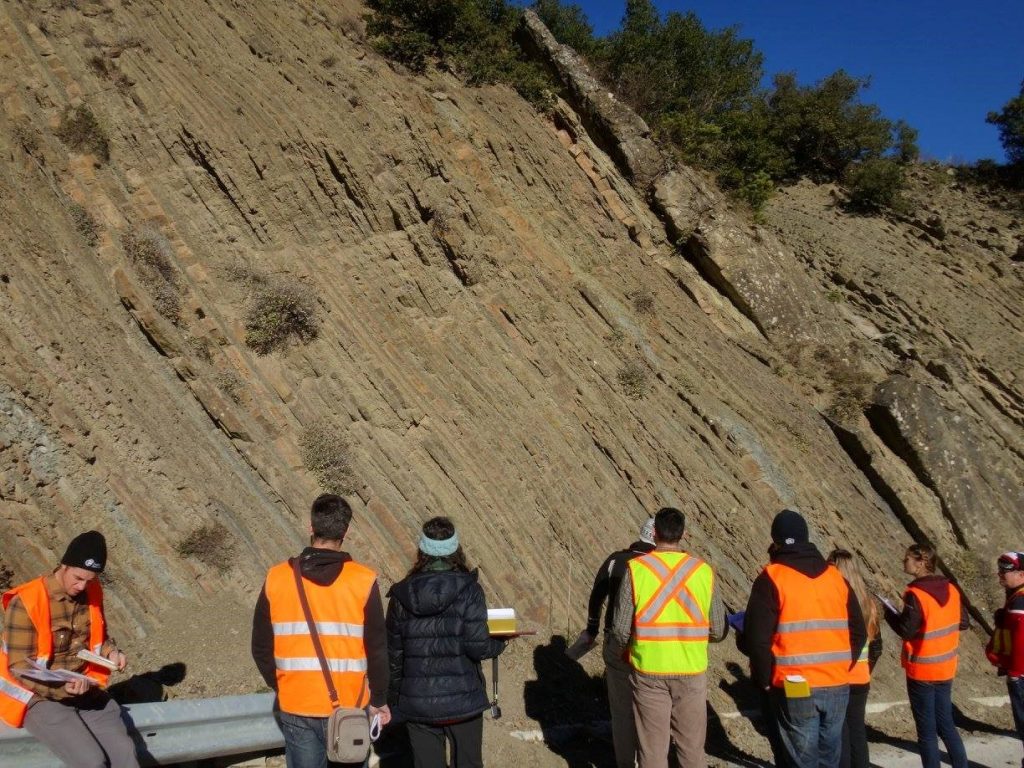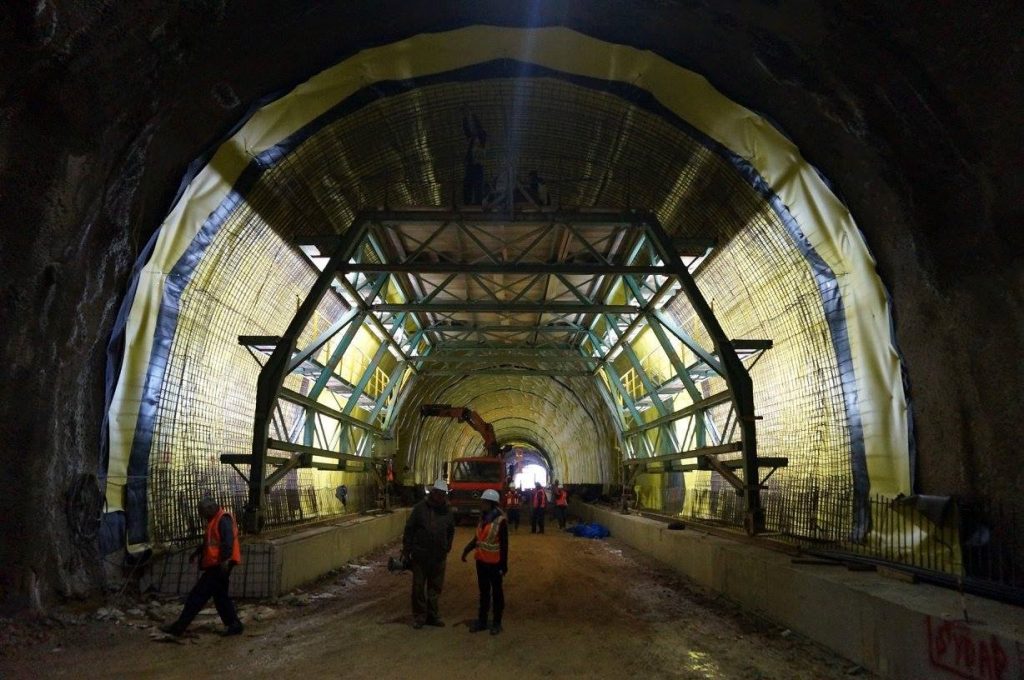
All participants of the field course at an outcrop site
GeoEngineering Technical Field Course in Greece, RMC Graduate Course
From Monday, December 7th, 2015 until Sunday, December 13th, 2015, two post-graduate students from the Civil Engineering Department of the Royal Military College of Canada (RMCC), Captain Stephen Holt (25116) and Second Lieutenant Daniel Cruz (26305), took part in a Geotechnical Field Course in Greece. The course was organized and taught by RMCC Associate Professor Dr. Nicholas Vlachopoulos (19930) from the Civil Engineering Department. As well, seven (7) other graduate students from the Department of Geological Engineering at Queen’s University also participated in the course. Also contributing to the instruction, guiding the discussions and providing input, was Professor Dr. Mark Diederichs from Queen’s University. This ‘Canadian Contingent’ was accompanied by eight (8) graduate students from the graduate program of the Geological Department of the Aristotle University of Thessaloniki (AUTH), and twenty-one (21) graduate students from the graduate program of the Schools of Mining and Metallurgical Engineering and Civil Engineering from the National Technical University of Athens (NTUA). The students had the pleasure of being accompanied by a world renowned expert in the tunnelling field, Dr. Paul Marinos, Professor Emeritus of the School of Civil Engineering of NTUA. Dr. Vassilios Marinos, Assistant Professor of the Department of Geology from AUTH also contributed with his expertise during the course. Throughout the week, the students had the opportunity of taking part in discussions and the analysis of different tunnelling sites at various stages of construction throughout Greece. While on-site, the students had the opportunity to learn from the individuals that have themselves, developed the classification and characterization of the complex rockmasses present in Greece today.
Figure 1: Dr. Vlachopoulos (19930), Capt. Holt (25116), and 2Lt Cruz (26305) in the Platamonas Tunnel
MORE…
Beginning and ending in Athens, the course circumnavigated most of Greece, exposing the students to most of the major geological zones of Greece. Despite spanning a small surface area, Greece is unique in that it finds itself at the convergent boundary between the African and Eurasian tectonic plates. This has led to the formation of a mountainous landscape as well as having created an area of intense tectonism that was seen in the form of faulting and folding of the various rockmasses seen throughout the course. This has created an extremely complex geology that has inherent and unique challenges when it comes to excavating within these rock types. Throughout the course, the graduate students were able to see the different challenges when tunnelling through materials with varying strengths and in regions with inherent landslide and seismic risks.
Figure 2: Overview of Sites Visited in Technical Field Trip (stops in yellow pins)
Departing Athens bright and early, Day 1 of the field course began with crossing continental Greece westward and travelling towards the Corinth Canal on the Attiki Odos Highway. The Attiki Odos runs East to West along Southern Greece, and includes tunnels in limestone in a tectonically active area, including the active fault of Kakia Skala or “the Evil Staircase.” Legend tells that young Theseus met the robber Skiron here. Skiron would force those travelling through to kneel over and wash his feet, proceeding to push them over the edge to be eaten by a giant turtle. Theseus is said to have pushed Skiron over the edge, making him the last victim of the giant turtle. Running parallel with the alignment of the road and coastline, the faults at Kakia Skala caused a realignment of the road further into the slope due to the possibility of seismic events and their effect on the slopes and faults in the region.
Figure 3: Standing in front of the face at the Panagopoula tunnel
The remaining two site visits of the day were an opportunity for the grad students to learn of the different degree of temporary support elements that can be utilized depending on the strength of the in situ material. Due to a major landslide in the area around the Panagopoula tunnel, the alignment of the road was modified and moved into the mountain in order to pass behind this landslide zone. This area is composed of a host of weak materials, steep slopes, and seismic activity – necessitating the use of a high degree of rock and soil support in and around the excavation. In contrast to the vast amount of support necessary at the Panagopoula tunnel, the Klokova Tunnel that was visited on the Ionian Highway, utilized a much less intensive use of temporary support, as the dominant rock formation here is a more coherent and thicker limestone than that present at the Panagopoala tunnel. The main support elements utilized here are widely spaced swellex bolts, lattice girders, shotcrete, and spot bolting. This visit provided a unique opportunity for everyone as the installation of spiles (swellex bolts) was witnessed, as well as the expansion of a swellex outside of a borehole!
Figure 4: Capt. Holt; a spile being installed at the face of the excavated tunnel
Day 2 began with more of an emphasis at the geology; firstly, the course stopped at a subterranean spring. Its source was influenced by karst, whereby large cavities form within limestone which can lead to serious complications with respect to tunnelling. The next stop was at Kallidromo tunnel where the students had a unique look at deceptively weak rocks called ophiolites. The insight gained was that what is apparent on the ground surface can oftentimes be deceptive at the depth of the tunnel alignment. The task was to infer the geology underground from the surface data and limited borehole information over the rail tunnel’s length. At first it seemed simple, however, tectonic activity in the area threw everything for a loop showing that you need to look at the macro scale in order to appreciate what happened locally.
On day 3, the students gained an appreciation for how geological assessments (such as those conducted on Day 2) become critical. On entering the tunnel, students immediately noticed something odd. Cracks and water were leaking through the final tunnel liner. Apparently, ophiolites were encountered unexpectedly during tunneling and resulted in a collapse of the neighbouring tunnel during excavation. In this tunnel, they had been more careful, but still, water and odd stresses were having an impact. Monitoring and instrumentation were employed in order to determine the rock behaviour and as well as the effectiveness of the remediation measures that were employed.
Figure 5: 2Lt Cruz looking at the final liner in the Platamonas tunnel
The trip then continued North East to a Metro extension in the east end of Thessaloniki. There, the students saw the excavation associated with a metro station and preparing parts of a Tunnel Boring Machine for the new tunnels. The students also had an opportunity to be briefed by the tunnel design engineer team within the metro. One critical part that was briefed was the need for surface monitoring in order to constantly assess the influence of the tunnelling works on the infrastructure above; such as apartments and businesses, but more crucially, historical buildings such as the Arch of Galerius, dating from the early 4th century AD, as well as a Mosque dating to the 15th century Ottoman invasion. All of which needed to be carefully monitored by electronic sensors and survey equipment to ensure that no damage was done as the TBMs excavated underneath. It was a great opportunity to combine history lessons and engineering.
Travelling from Thessaloniki on day 4, the students had the unique chance to visit the Olympia and Skouries mine sites in Chalkidiki. The mines are quite rich in copper, gold, silver, and zinc in both surface and subsurface deposits. Greece has not played a significant role in the mining industry for decades so there are many unique challenges presented by the development of this site on a social, political, environmental and technical level. It was a wonderful opportunity to see how design and construction practices in mining differ from conventional highway or rail tunnels as well as the significant focus on worker safety and the environment.
The last two days of the fieldtrip focused around Northern Greece along the Egnatia Odos Highway. The highway spans entirely across Northern Greece, running East to West. The importance of understanding the geological model of every location along its construction was truly emphasized here as the highway crosses perpendicularly across the main geotectonic units in Greece. This makes the construction of the highway an excellent showcase of geotechnical problem solving and remediation techniques that were conducted throughout the project. The highway spans 680km, with a total of 77 twin tunnels, combining for a total bore length of 100km. Although this only accounts for roughly over 10% of the highway’s distance, the tunnels accounted for 35% of the total cost of the project.
Various contrasting factors influenced the design of the tunnels in this region, as was seen at the different stops along the highway. Stopping at the now complete S3 tunnel that has been the topic of these slope stability concerns for years, the students were able to see the remediation techniques that were utilized in order to stabilize the tunnel. Data from geotechnical monitoring determined the extent of a slope failure surface crossing across the tunnels, the movements being exhibited on the temporary support shell as cracks and local failures. The amount of stabilization measures that had to take place in order to remediate the situation was quite impressive and included a 30m long concrete pile wall, permanent pre-stressed anchors, as well as the application of cement grout around both tunnels.
Figure 6: Dr. P. Marinos estimating the rock strength at a gneiss outcrop
Stopping at different outcrops along the Egnatia Odos, the importance of understanding the geological environment present throughout the alignment of the highway was made obvious. The highway can be broken up into 5 main geological sections. Stops were made at flysch, molasses, and gneiss outcrops, the various challenges associated with the application of GSI (rock mass strength estimation tool) covered in open ended discussions with the professors. At a location off the Egnatia Highway close to Metsovo, different flysch outcrops of varying strength and coherency were viewed and analysed. Dr. Vassilios Marinos, took the students through the characterization of the different flysch outcrops, utilizing a flysch GSI chart made specifically for this material. Having been closely involved with the development of this chart himself, this was truly a memorable experience that helped increase the students’ understanding of characterizing these complex flysch rock masses.
Figure 7: Analysing the chaotic flysch at an outcrop off Egnatia Odos
The visits in Northern Greece were also special in that they encompassed varying stages of the tunnel excavating procedure. Most of the tunnels that were visited along the Egnatia Odos had already been completed; the final liner and different monitoring systems already in place (including fire suppression systems and air quality monitoring). At a tunnel site which will connect Greece and Albania once completed, the actual installation of the liner and all of its separate components was witnessed as can be seen in Figure 9. Not only did this help give perspective to the vast amount of work and difficulty in logistically managing the separate moving parts of a tunnelling project, but the ensuing reflections and conversations with staff and on-site experts as well as other individuals who worked closely with these projects was a remarkable and thought provoking experience for all.
Figure 8: Installation of the final liner at Krystalopigi tunnel
Not only was this week a memorable one from a technical perspective, but it was also one that the students will remember as a time of sharing amongst cultures. For the duration of the visit, the generosity as well as warm culture of the Greek people was a highlight, as at no moment was there a lack of hospitality or kindness. The Canadian Contingent enjoyed learning about the Greek culture, and feasting in their delicious and varied cuisine. This field course helped all those that were privileged to take part in it to grow personally and take a little bit of Greece back to Canada with them; as Dr. Paul Marinos himself put it, “you are now all Greek!”
“For the duration of the visit, the generosity as well as warm culture of the Greek people was a highlight, as at no moment was there a lack of hospitality or kindness.”
In the end, the geoengineering technical field course was a resounding success. The vast amount of different tunnelling construction sites that were visited throughout the week was quite spectacular. The access to such sites was outstanding. The graduate students were able to see a number of tunnels at different stages of development, helping piece together the scope and complexity of tunnelling within diverse geological zones such as those found in Greece. Not only was the importance of a technically sound design highlighted in the many project sites visited, but also the various social, economical, and environmental factors that can affect a project throughout its lifetime. The students were able to see many of the various topics that they have been privy to in their education; this visit helped make the connection between what was seen in the classroom and how this translates to real world applications.
The relationship between the universities that took part of this week should be fostered in order to be able to provide future students with similar opportunities in order to expand their horizons and continue to enrich the post-graduate programs at all universities with these experiences with real-life problems and sharing of knowledge between professionals that add great value to their learning environment.
The Canadian Embassy in Greece is certainly aware of this 10+ year educational & collaborative relationship between the universities and was highlighted recently in it news release: https://www.facebook.com/CanadainGreece/photos/a.122276554649366.1073741826.113933518817003/437920033085015/?type=3&theater
A special thanks to everyone that made this week possible, especially, Dr. Nicholas Vlachopoulos and Dr. Paul Marinos.
Daniel Felipe Cruz
2Lt
26305
Stephen Holt
Capt
25116










